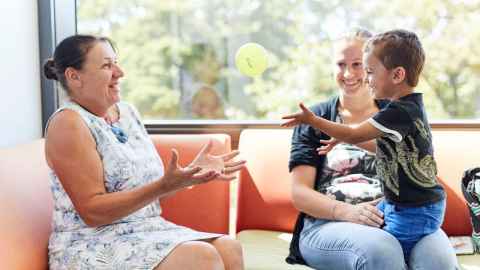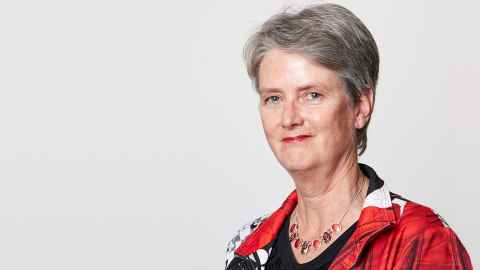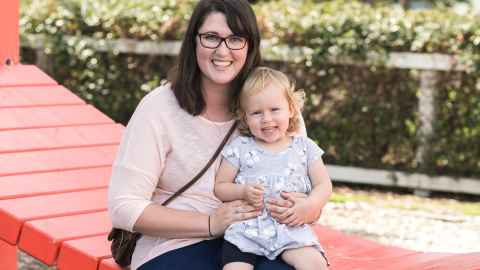Major US funding boost for NZ-Aus trial of sugar gel for newborns
24 May 2018
New Zealand-led research that could improve the care of up to a third of all babies born and potentially prevent brain damage in infancy has received a $2.8 million boost from the United States.

New Zealand-led research that could improve the care of up to a third of all babies born and potentially prevent brain damage in infancy has received a $2.8 million boost from the United States.
The funding is for research underway at hospitals in Aotearoa New Zealand and Australia investigating whether a dextrose (sugar) gel could prevent a common, potentially serious condition in newborns.
The grant of US$1,968,326 over five years comes from the National Institutes of Health, the main agency of the US government responsible for biomedical and public health research.
The study is led by Distinguished Professor Jane Harding from the University of Auckland-based Liggins Institute. She says it is highly unusual for a New Zealand study that is not part of a US-based collaboration to receive this grant. “This shows how unique and important this research is. We are delighted because this will allow us to be sure we can finish the study, including the follow-up.”
...even brief periods of slightly low blood sugar are associated with increased difficulties at 4.5 years, so finding a preventative may well be important.
The study, dubbed hPOD, involves rubbing either the sugar gel, or a placebo, into the inside cheeks of at-risk newborns an hour after birth. Researchers believe the inexpensive gel could prevent them from getting a common condition called neonatal hypoglycaemia (low blood sugar) - the only readily preventable cause of brain damage in infancy. (hPOD stands for hypoglycaemia Prevention with Oral Dextrose.)
Neonatal hypoglycaemia affects one in six babies. Left untreated, it can cause developmental delay, brain damage and lowered education outcomes later in life. The ground-breaking 2013 “Sugar Babies Study”, also led by Professor Harding, showed the sugar gel works as a treatment for low blood sugar, and it is now widely used in Aotearoa and a growing number of other countries, including the UK, Australia, and the US.
“We thought if it works well to treat babies with low blood sugar, could we use it to prevent babies getting low blood sugars?” says Professor Harding, a preeminent New Zealand paediatrician. “If we could do that, we might reduce the number of blood tests they need, reduce the amount of angst that families experience, and potentially even prevent brain damage.”
Low blood sugar often means babies have to go into an intensive or special care unit, separating mother and baby just as they are trying to establish breastfeeding. Currently, there is no proven preventative, and many at-risk newborns are given formula, which can also disrupt breastfeeding.
At-risk babies – up to a third of all born - are those born preterm, smaller or larger than usual, and babies whose mothers have diabetes.

The research team tracked some of the babies from 2013 Sugar Babies Study. They found that children who had experienced low blood sugar as newborns were two to three times more likely to have difficulties with executive function (skills for problem-solving, planning, memory and attention) and visual-motor co-ordination (skills for fine control of movement, and understanding what you see) at age 4.5 years than children who had normal blood sugar levels. Strikingly, children who had experienced a drop in blood sugar not detected by routine blood sugar monitoring were four times more likely to have difficulties with these skills.
“This shows that even brief periods of slightly low blood sugar are associated with increased difficulties at 4.5 years, so finding a preventative may well be important,” says Professor Harding.
The hPOD trial is about halfway towards its target of 2129 newborns, and is being run at: Auckland City Hospital, North Shore Hospital, Whangarei Hospital, Waikato Hospital, Tauranga Hospital, Hawkes Bay Hospital, Whakatane Hospital, Southland Hospital, and five Australian hospitals.
Pregnant women interested in finding out more can visit the hPOD study page, or email hPOD@auckland.ac.nz. Watch this video clip of Professor Harding talking about hPOD.
The study is also funded by the Health Research Council, CureKids, Lottery Health and the Waikato Medical Research Foundation.
Amanda and Xavier's story
As a nurse who had worked in NICU, West Aucklander Amanda Kamani knew that her type 1 diabetes put her babies at risk of neonatal hypoglycaemia – a potentially dangerous dip in blood sugar levels following birth. She did everything she could to regulate her own blood sugar levels during her pregnancy – some days testing herself up to 18 times.
“I was really worried that my first baby, Tobias, would have low blood sugars and be put in NICU. He probably would have ended up with a tube down his tummy. It can be such a huge thing – before they started using the sugar gel treatment, you had to top them up all the time with formula, and sometimes they’d get used to the bottle and you’d have to wean them off that to get established with breast feeding. And of course baby’s not with mum.”
She leapt at the chance to sign up Tobias, now four, to a prequel study to hPOD, designed to determine the best dose of dextrose (sugar) gel for preventing low blood sugars. She also enrolled her second son, Xavier, now two, in the main hPOD trial, which is investigating whether giving the gel to at-risk newborns can prevent low blood sugars.
“It was so easy – just a prick on the heel to test their blood sugars, which they would have had done anyway because both babies were at-risk, and then rubbing in the gel. Xavier was a little low so they gave him the sugar gel, then he was fine – no NICU or anything. Nobody at any stage had to take the babies away, all along either me or my husband Sam were holding them.”
She says, “It would be great if this simple gel could reduce the incidence of low blood sugars, keeping mums and babies together, and increasing the quality of life for so many babies.”

Vanessa and daughter Emma's story
Like many expectant mums, Vanessa Davidson of Matamata had never heard of gestational diabetes until she was diagnosed with it during her first pregnancy. Gestational, or pregnancy-related, diabetes affects around one in 12 pregnant women in Aotearoa New Zealand, and the incidence is rising.
Babies whose mothers have this, or any type of diabetes, are at a higher risk of developing neonatal hypoglycaemia, a sustained dip in blood sugars at birth that can cause brain damage. Vanessa’s midwife explained this to her, and asked if she wanted to join a major clinical trial underway to see whether giving dextrose (sugar) gel to at-risk newborns can prevent low blood sugars. The sugar gel is already used to treat low blood sugars in newborns.
“I said yes - I liked the idea of helping out other mums,” says Vanessa. Participating was very easy. At birth, baby Emma received the standard heel-prick blood sugar test performed on all at-risk newborns, and then had gel rubbed into the inside of her cheek.
Almost two years later, a member of the research team visited Vanessa and Emma to check up on the toddler’s development as part of a follow-up study.
“It’s been exciting to see how Emma’s developing, and to see what’s normal,” says Vanessa.
“I would absolutely encourage other pregnant women to join hPOD. It’s a great thing to be part of, and it’s really satisfying knowing that you’re helping other mums – my children’s children, or even friends who haven’t had kids yet could benefit from this study’s findings.”
Media queries
Nicola Shepheard | Media Adviser
Tel: 09 923 1515
Mob: 027 537 1319
Email: n.shepheard@auckland.ac.nz